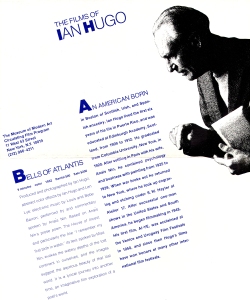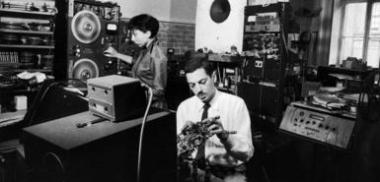Summary: Louis and Bebe Barron, early electronic music explorers who were championed by Anais Nin, based much of their circuitry on the model presented by Norbert Wiener and believed in the cybernetics philosophy that the circuits took on a life of their own. The sounds produced were not artificially controlled by the Barrons, but were in a sense organically created by the automatic recalculations within the electronic devices. When the Barrons crashed an art show given by MGM head Dory Sherry, they laid the groundwork for getting the job for the soundtrack of the pivotal sci-fi movie Forbidden Planet, in fact taking the job from fellow modern music trailblazer Harry Partch (also championed by Nin). The result was a standard for sci-fi soundtracks that are produce to this day.
Posts Tagged ‘Louis Barron’
Bebe Barron on Cybernetics and Forbidden Planet
April 14, 2009Posted in Anais Nin Friends | Leave a Comment »
Tags: Anais Nin, bebe barron, Cybernetics, Dory Sherry, Forbidden Planet, Harry Partch, Louis Barron, Norbert Wiener
The Barrons: The music behind ‘Bells of Atlantis’
April 11, 2009
If Anaïs Nin was known for her diaries, she should also be known for her circle of friends, which included the electronic music pioneers Louis and Bebe Barron. The friendship ultimately turned into collaboration with Nin and Ian Hugo (Hugh Guiler, Nin’s husband) on his experimental film Bells of Atlantis (1952). The music and images work together to provide the audience with a full range of stimulation, both aural and visual, not to mention literary as Nin recites lines from her House of Incest (1936), upon which the film is based. Thanks to NPR, a retrospective of the Barrons and their impact on the music world can be seen here.
Bebe Barron died in April 2008; a video of her last interview can be seen here, conducted by Steven Reigns and Ian McKinnon.
Posted in Hugh Guiler | Leave a Comment »
Tags: Anais Nin, bebe barron, Bells of Atlantis, House of Incest, Hugh Guiler, Ian Hugo, Louis Barron, steven reigns
Ian Hugo: Filmmaker
March 10, 2009
When Hugh Guiler, Anaïs Nin’s banker husband, began his artistic career as an engraver, he chose to use the name Ian Hugo, supposedly so that his art would be separate from his career. In Guiler’s mind, there was a sense of intolerance between the financial and artistic worlds, and he did not want the two intertwined. Guiler’s engravings found their way into Nin’s hand-printed editions during the 1940s, perhaps most notably the Gemor edition of Under a Glass Bell (the promotional photo of which can be seen on the cover of A Café in Space, Vol. 2). By 1950, Guiler began experimenting with film and became a truly respected avant-garde filmmaker, using superimposition and other effects to reflect his vision on the screen.
At a May 27, 1977 lecture, he said after screening his Bells of Atlantis (based on water images presented in Nin’s first work of fiction, The House of Incest, and in which Nin appears and narrates): “Thank you for your kind response, which I am sure is also meant as a tribute to Anaïs Nin. I do think that this film does bring her closer to you—to her style as a poetic writer of the first order, and her presence as an extraordinarily sensitive, and warm human being. I can certainly testify personally to this through the almost 54 years that we were married, to the time of her death in January of this year.” (It should be pointed out that there was an audible gasp by the audience, since they only knew Ian Hugo as an artistic collaborator of Nin.) “And I will add that her physical beauty seemed to glow as if from some inner light which, as I now see more clearly, enabled her to explore, day by day, ‘the lost continent within ourselves’ (a phrase by the poet Marianne Moore in referring to Bells of Atlantis). And it is only now that I fully realize how much I owed to her presence and her encouragement all those years in trying to explore my own ‘lost continent’ which I first tried to reach out to in making this film.” The complete lecture will be published in next year’s A Café in Space.
The 9 minute film, finished in 1952, with a score from electronic music pioneers Louis and Bebe Barron, can be viewed (in less than pristine quality) by clicking here. (Courtesy of UbuWeb) There is also a filmography of Guiler’s work, thanks to Robert Haller.
Posted in A Cafe in Space, Hugh Guiler | 1 Comment »
Tags: Anais Nin, bebe barron, Bells of Atlantis, Hugh Guiler, Ian Hugo, Louis Barron
